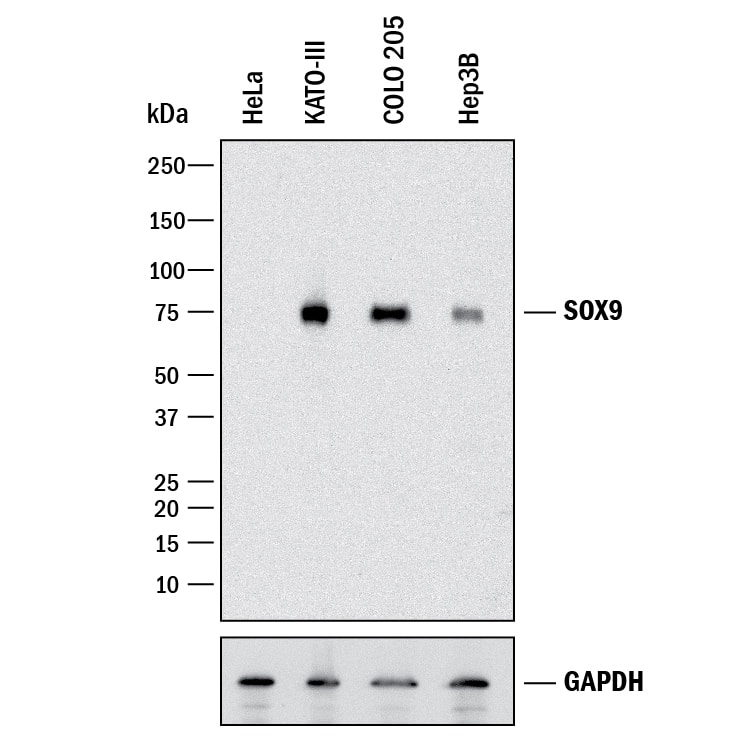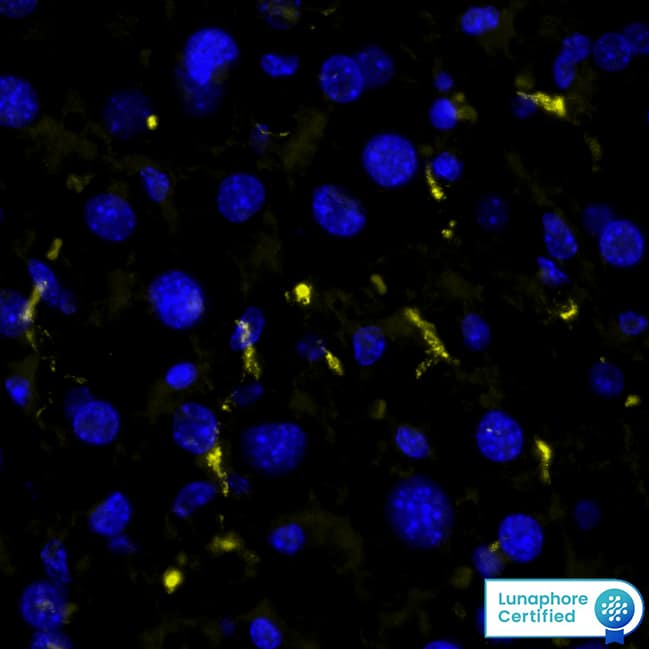Mouse Erythropoietin R Antibody Summary
Ala25-Pro249
Accession # P14753
Customers also Viewed
Applications
Please Note: Optimal dilutions should be determined by each laboratory for each application. General Protocols are available in the Technical Information section on our website.
Scientific Data
 View Larger
View Larger
Erythropoietin R in Mouse Bone Marrow Cells. Erythropoietin R was detected in immersion fixed mouse bone marrow cells using Goat Anti-Mouse Erythropoietin R Antigen Affinity-purified Polyclonal Antibody (Catalog # AF1390) at 15 µg/mL for 3 hours at room temperature. Cells were stained using the NorthernLights™ 557-conjugated Anti-Goat IgG Secondary Antibody (red; Catalog # NL001) and counterstained with DAPI (blue). Specific staining was localized to cell surfaces. View our protocol for Fluorescent ICC Staining of Non-adherent Cells.
Preparation and Storage
- 12 months from date of receipt, -20 to -70 °C as supplied.
- 1 month, 2 to 8 °C under sterile conditions after reconstitution.
- 6 months, -20 to -70 °C under sterile conditions after reconstitution.
Background: Erythropoietin R
Erythropoietin (Epo), a glycoprotein produced primarily by the kidney, is the principal factor that regulates erythropoiesis by stimulating the proliferation and differentiation of erythroid progenitor cells. The biological effects of Epo are mediated by the erythropoietin receptor (Epo R). A member of the hematopoietic growth factor receptor superfamily which includes IL-2, IL-3, IL-4, IL-5, IL-6, IL-7, GM-CSF, G-CSF, thrombopoietin, LIF, CNTF, growth hormone, and prolactin, Epo R is expressed not only by erythroid cells but also by embryonic stem cells, endothelial cells, and neural cells (1). Mouse Epo R cDNA encode a type I membrane‑spanning protein with 507 amino acid (aa) residues. Mouse Epo R has a 24 aa hydrophobic signal peptide, a 225 aa extracellular domain, a 22 aa transmembrane domain, and a 236 aa intracellular domain. At the protein sequence level, the human Epo R is approximately 82% identical to the mouse protein (2). Mouse and human Epo R both contain 11 cysteine residues and an N-linked glycosylation site. Mouse Epo R, however, contains two disulfide bridges not found with human Epo R. In common with other hematopoietic growth factor receptor superfamily members, mouse Epo R has 4 positionally conserved cysteines in its extracellular domain, a tryptophan-serine-X-tryptophan-serine (WSXWS) motif or its homolog located near the transmembrane region, and lacks kinase motifs in its intracellular domain. Based on its amino acid composition the molecular weight of Epo R would be 55 kDa but after post translational modification including glycosylation and tyrosine and serine‑threonine phosphorylation the molecular weight can be as high as 78 kDa (1). As a result of alternative splicing of the Epo R gene, cDNA clones encoding a truncated form of the Epo R as well as a soluble form of Epo R has been found (2, 3). The presence of a soluble form of the Epo R has also been detected in human sera. Recombinant soluble Epo R binds Epo with high affinity and is a potent Epo antagonist (3).
- Spivak, J.L. (2001) in Cytokine Reference, Oppenhiem, J.J. and M. Feldmann, eds. Academic Press, New York, p. 941.
- Kuramochi, S., Y. Ikawa and K. Todokoro (1990) J. Mol. Biol. 216:567.
- Baynes, R.D. et al. (1993) Blood 82:2088.
Product Datasheets
Citations for Mouse Erythropoietin R Antibody
R&D Systems personnel manually curate a database that contains references using R&D Systems products. The data collected includes not only links to publications in PubMed, but also provides information about sample types, species, and experimental conditions.
4
Citations: Showing 1 - 4
Filter your results:
Filter by:
-
Erythropoietin regulates energy metabolism through EPO-EpoR-RUNX1 axis
Authors: Yin, W;Rajvanshi, PK;Rogers, HM;Yoshida, T;Kopp, JB;An, X;Gassmann, M;Noguchi, CT;
Nature communications
Species: Mouse
Sample Types: Whole Tissue
Applications: Immunohistochemistry -
Dysregulation of erythropoiesis and altered erythroblastic NMDA receptor-mediated calcium influx in Lrfn2-deficient mice
Authors: R Maekawa, H Muto, M Hatayama, J Aruga
PLoS ONE, 2021-01-22;16(1):e0245624.
Species: Mouse
Sample Types: Whole Cells
Applications: ICC -
Postnatal erythropoietin treatment mitigates neural cell loss after systemic prenatal hypoxic-ischemic injury
Authors: Marcus Mazur, Robert H. Miller, Shenandoah Robinson
Journal of Neurosurgery: Pediatrics
-
Erythropoietin promotes survival of retinal ganglion cells in DBA/2J glaucoma mice.
Authors: Zhong L, Bradley J, Schubert W, Ahmed E, Adamis AP, Shima DT, Robinson GS, Ng YS
Invest. Ophthalmol. Vis. Sci., 2007-03-01;48(3):1212-8.
Species: Mouse
Sample Types: Whole Tissue
Applications: IHC-Fr
FAQs
No product specific FAQs exist for this product, however you may
View all Antibody FAQsIsotype Controls
Reconstitution Buffers
Secondary Antibodies
Reviews for Mouse Erythropoietin R Antibody
There are currently no reviews for this product. Be the first to review Mouse Erythropoietin R Antibody and earn rewards!
Have you used Mouse Erythropoietin R Antibody?
Submit a review and receive an Amazon gift card.
$25/€18/£15/$25CAN/¥75 Yuan/¥2500 Yen for a review with an image
$10/€7/£6/$10 CAD/¥70 Yuan/¥1110 Yen for a review without an image
















